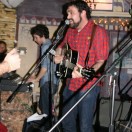The planet known as twee might be in the Descendant at the moment, but no one told The Yellow Dress that.
The seven-piece San Francisco band wears its heart on its sleeve, fashioning adorable ballads out of acoustic guitar strums, hand claps, whistling, and frontman Dan Weiss’ delirious game-show-host vocals. On their just-released sophomore album, Humblebees, The Yellow Dress leave apathy and pretentiousness to the buzz bands, opting instead for relentlessly cheery, homespun ditties with a heartfelt edge.
That unique blend of sunshine and rain has drawn some intriguing comparisons. According to Weiss, “We’ve been compared to The Magnetic Fields with less self-loathing, The Velvet Underground with less drugs, and a recent review of our album called one of the songs the closest equivalent twee-pop has so far to David Bowie’s ‘Heroes.'”
Echoes of those artists can be heard in The Yellow Dress’ music, but their other influences are even more varied. Weiss was kind enough to provide us with a list of them, which you can read below.
The Yellow Dress Poetic Memory:
1. DIY music: While the internet has I suspected made it harder than ever to make a real living off of music, it’s also made it incredibly easy to break out of any given local music scene and connect with like minded folks. Since forming we’ve had the great pleasure to play with some pretty incredible and inspiring label-less (or practically label-less) groups across the country that have been huge influences on us (and this record in particular). A few particular notables: Spirits of the Red City (Minneapolis, MN), Adam Balbo (from here in SF), Go Slowpoke (Bellingham, WA) Fishboy (Denton, TX), and (the sadly defunct) Hello The Mind Control (Phoenix, AZ).
2. 1950s and 60s Gospel: Man, gospel music is great. Growing up a completely secular household (son of a non-practicing Protestant and a acupuncturist Jew) I had no real idea how incredible this sort of thing can be, the pure ecstatic energy of a room full of devoted people singing together. If we could capture even a sliver of that I’d be content. The Motown compilation Shade of Gospel Soul in particular is a top-ten all-time album.
3. Wes Anderson: I’m pretty sure you’re not supposed to love Wes Anderson anymore in 2011, but I totally do. I saw Rushmore eight times in the theatre and that’s probably had a bigger impact on me aesthetically than anything else I can think of. When people write about us they always talk about how happy our music is, incidentally I think Wes Anderson’s comedies are some of the most depressing films ever made. This brings us to…
4. Crushing depression: One time a paper in Santa Fe referred to us as the Magnetic Fields with less self loathing, to which I say “I promise I hate myself too.” Most of the songs on our new album were written after a particularly brutal break-up (yawn) when I found myself completely unable to sleep past 4 am. I’d lie in bed with my guitar until it was a socially acceptable time to leave the house. Eventually I got over myself. It’s a lot harder to write songs when everything is going ok.
5. Books: I work in an independent bookstore in SF, I studied creative writing and have worked for Dave Eggers and Stephen Elliott. Our first album was a reference to the Joseph Mitchell essay “Joe Gould’s Secret” and this one started out as a concept album inspired by the graphic novel Poor Sailor by Sammy Harkham (thus the first track). Some other books that went into this album: The Tenants of Moonbloom by Edward Lewis Wallant, The Summer Book by Tove Jansson, 60 Stories by Donald Barthelme, The Convalescent by Jessica Anthony, Adverbs by Daniel Handler, and Goodbye Chunky Rice by Craig Thompson.
